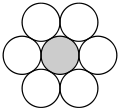
A | B | C | D | E | F | G | H | CH | I | J | K | L | M | N | O | P | Q | R | S | T | U | V | W | X | Y | Z | 0 | 1 | 2 | 3 | 4 | 5 | 6 | 7 | 8 | 9
This article includes a list of general references, but it lacks sufficient corresponding inline citations. (March 2011) |
| Hexagonal tiling | |
|---|---|
 | |
| Type | Regular tiling |
| Vertex configuration | 6.6.6 (or 63) |
| Face configuration | V3.3.3.3.3.3 (or V36) |
| Schläfli symbol(s) | {6,3} t{3,6} |
| Wythoff symbol(s) | 3 | 6 2 2 6 | 3 3 3 3 | |
| Coxeter diagram(s) | |
| Symmetry | p6m, , (*632) |
| Rotation symmetry | p6, +, (632) |
| Dual | Triangular tiling |
| Properties | Vertex-transitive, edge-transitive, face-transitive |
In geometry, the hexagonal tiling or hexagonal tessellation is a regular tiling of the Euclidean plane, in which exactly three hexagons meet at each vertex. It has Schläfli symbol of {6,3} or t{3,6} (as a truncated triangular tiling).
English mathematician John Conway called it a hextille.
The internal angle of the hexagon is 120 degrees, so three hexagons at a point make a full 360 degrees. It is one of three regular tilings of the plane. The other two are the triangular tiling and the square tiling.
Applications
Hexagonal tiling is the densest way to arrange circles in two dimensions. The honeycomb conjecture states that hexagonal tiling is the best way to divide a surface into regions of equal area with the least total perimeter. The optimal three-dimensional structure for making honeycomb (or rather, soap bubbles) was investigated by Lord Kelvin, who believed that the Kelvin structure (or body-centered cubic lattice) is optimal. However, the less regular Weaire–Phelan structure is slightly better.
This structure exists naturally in the form of graphite, where each sheet of graphene resembles chicken wire, with strong covalent carbon bonds. Tubular graphene sheets have been synthesised, known as carbon nanotubes. They have many potential applications, due to their high tensile strength and electrical properties. Silicene is similar.
Chicken wire consists of a hexagonal lattice (often not regular) of wires.
-
The densest circle packing is arranged like the hexagons in this tiling
-
Chicken wire fencing
-
A carbon nanotube can be seen as a hexagon tiling on a cylindrical surface
-
Hexagonal Persian tile c.1955
The hexagonal tiling appears in many crystals. In three dimensions, the face-centered cubic and hexagonal close packing are common crystal structures. They are the densest sphere packings in three dimensions. Structurally, they comprise parallel layers of hexagonal tilings, similar to the structure of graphite. They differ in the way that the layers are staggered from each other, with the face-centered cubic being the more regular of the two. Pure copper, amongst other materials, forms a face-centered cubic lattice.
Uniform colorings
There are three distinct uniform colorings of a hexagonal tiling, all generated from reflective symmetry of Wythoff constructions. The (h,k) represent the periodic repeat of one colored tile, counting hexagonal distances as h first, and k second. The same counting is used in the Goldberg polyhedra, with a notation {p+,3}h,k, and can be applied to hyperbolic tilings for p > 6.
| k-uniform | 1-uniform | 2-uniform | 3-uniform | ||||
|---|---|---|---|---|---|---|---|
| Symmetry | p6m, (*632) | p3m1, (*333) | p6m, (*632) | p6, (632) | |||
| Picture | 
|

|

|

|
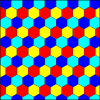
|

|

|
| Colors | 1 | 2 | 3 | 2 | 4 | 2 | 7 |
| (h,k) | (1,0) | (1,1) | (2,0) | (2,1) | |||
| Schläfli | {6,3} | t{3,6} | t{3} | ||||
| Wythoff | 3 | 6 2 | 2 6 | 3 | 3 3 3 | | ||||
| Coxeter | |||||||
| Conway | H | tΔ | cH=t6daH | wH=t6dsH | |||
The 3-color tiling is a tessellation generated by the order-3 permutohedrons.
Chamfered hexagonal tiling
A chamfered hexagonal tiling replaces edges with new hexagons and transforms into another hexagonal tiling. In the limit, the original faces disappear, and the new hexagons degenerate into rhombi, and it becomes a rhombic tiling.

| Hexagons (H) | Chamfered hexagons (cH) | Rhombi (daH) | ||
|---|---|---|---|---|
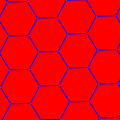
|

|

|

|

|
Related tilings
The hexagons can be dissected into sets of 6 triangles. This process leads to two 2-uniform tilings, and the triangular tiling:
| Regular tiling | Dissection | 2-uniform tilings | Regular tiling | Inset | Dual Tilings | |
|---|---|---|---|---|---|---|
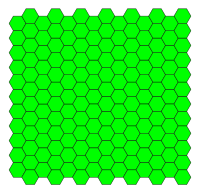 Original |
 
|
 1/3 dissected |
 2/3 dissected |
 fully dissected |

|
 E to IH to FH to H |
The hexagonal tiling can be considered an elongated rhombic tiling, where each vertex of the rhombic tiling is stretched into a new edge. This is similar to the relation of the rhombic dodecahedron and the rhombo-hexagonal dodecahedron tessellations in 3 dimensions.
 Rhombic tiling |
 Hexagonal tiling |
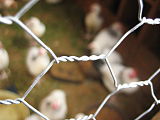 Fencing uses this relation |
It is also possible to subdivide the prototiles of certain hexagonal tilings by two, three, four or nine equal pentagons:
 Pentagonal tiling type 1 with overlays of regular hexagons (each comprising 2 pentagons). |
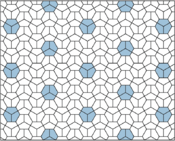 pentagonal tiling type 3 with overlays of regular hexagons (each comprising 3 pentagons). |
 Pentagonal tiling type 4 with overlays of semiregular hexagons (each comprising 4 pentagons). |
 Pentagonal tiling type 3 with overlays of two sizes of regular hexagons (comprising 3 and 9 pentagons respectively). |
Symmetry mutations
This tiling is topologically related as a part of a sequence of regular tilings with hexagonal faces, starting with the hexagonal tiling, with Schläfli symbol {6,n}, and Coxeter diagram ![]()
![]()
![]()
![]()
![]() , progressing to infinity.
, progressing to infinity.
| *n62 symmetry mutation of regular tilings: {6,n} | ||||||||
|---|---|---|---|---|---|---|---|---|
| Spherical | Euclidean | Hyperbolic tilings | ||||||
 {6,2} |
 {6,3} |
 {6,4} |
 {6,5} |
 {6,6} |
 {6,7} |
 {6,8} |
... |  {6,∞} |
This tiling is topologically related to regular polyhedra with vertex figure n3, as a part of a sequence that continues into the hyperbolic plane.
| *n32 symmetry mutation of regular tilings: {n,3} | |||||||||||
|---|---|---|---|---|---|---|---|---|---|---|---|
| Spherical | Euclidean | Compact hyperb. | Paraco. | Noncompact hyperbolic | |||||||

|

|

|

|

|

|

|

|

|

|

|

|
| {2,3} | {3,3} | {4,3} | {5,3} | {6,3} | {7,3} | {8,3} | {∞,3} | {12i,3} | {9i,3} | {6i,3} | {3i,3} |
It is similarly related to the uniform truncated polyhedra with vertex figure n.6.6.
| *n32 symmetry mutation of truncated tilings: n.6.6 | ||||||||||||
|---|---|---|---|---|---|---|---|---|---|---|---|---|
| Sym. *n42 |
Spherical | Euclid. | Compact | Parac. | Noncompact hyperbolic | |||||||
| *232 |
*332 |
*432 |
*532 |
*632 |
*732 |
*832 ... |
*∞32 |
|||||
| Truncated figures |

|

|

|

|

|

|

|

|

|

|

| |
| Config. | 2.6.6 | 3.6.6 | 4.6.6 | 5.6.6 | 6.6.6 | 7.6.6 | 8.6.6 | ∞.6.6 | 12i.6.6 | 9i.6.6 | 6i.6.6 | |
| n-kis figures |

|

|

|

|

|

|

|

|
||||
| Config. | V2.6.6 | V3.6.6 | V4.6.6 | V5.6.6 | V6.6.6 | V7.6.6 | V8.6.6 | V∞.6.6 | V12i.6.6 | V9i.6.6 | V6i.6.6 | |
This tiling is also part of a sequence of truncated rhombic polyhedra and tilings with Coxeter group symmetry. The cube can be seen as a rhombic hexahedron where the rhombi are squares. The truncated forms have regular n-gons at the truncated vertices, and nonregular hexagonal faces.
| Symmetry mutations of dual quasiregular tilings: V(3.n)2 | |||||||||||
|---|---|---|---|---|---|---|---|---|---|---|---|
| *n32 | Spherical | Euclidean | Hyperbolic | ||||||||
| *332 | *432 | *532 | *632 | *732 | *832... | *∞32 | |||||
| Tiling | 
|

|

|

|

|

|

| ||||
| Conf. | V(3.3)2 | V(3.4)2 | V(3.5)2 | V(3.6)2 | V(3.7)2 | V(3.8)2 | V(3.∞)2 | ||||
Wythoff constructions from hexagonal and triangular tilings
Like the uniform polyhedra there are eight uniform tilings that can be based on the regular hexagonal tiling (or the dual triangular tiling).
Drawing the tiles colored red on the original faces, yellow at the original vertices, and blue along the original edges, there are 8 forms, 7 of which are topologically distinct. (The truncated triangular tiling is topologically identical to the hexagonal tiling.)
| Uniform hexagonal/triangular tilings | ||||||||
|---|---|---|---|---|---|---|---|---|
| Fundamental domains |
Symmetry: , (*632) | 6,3+, (632) | ||||||
| {6,3} | t{6,3} | r{6,3} | t{3,6} | {3,6} | rr{6,3} | tr{6,3} | sr{6,3} | |

|

|

|

|

|

|

|

|

|
| Config. | 63 | 3.12.12 | (6.3)2 | 6.6.6 | 36 | 3.4.6.4 | 4.6.12 | 3.3.3.3.6 |
Text je dostupný za podmienok Creative Commons Attribution/Share-Alike License 3.0 Unported; prípadne za ďalších podmienok. Podrobnejšie informácie nájdete na stránke Podmienky použitia.
Antropológia
Aplikované vedy
Bibliometria
Dejiny vedy
Encyklopédie
Filozofia vedy
Forenzné vedy
Humanitné vedy
Knižničná veda
Kryogenika
Kryptológia
Kulturológia
Literárna veda
Medzidisciplinárne oblasti
Metódy kvantitatívnej analýzy
Metavedy
Metodika
Text je dostupný za podmienok Creative
Commons Attribution/Share-Alike License 3.0 Unported; prípadne za ďalších
podmienok.
Podrobnejšie informácie nájdete na stránke Podmienky
použitia.
www.astronomia.sk | www.biologia.sk | www.botanika.sk | www.dejiny.sk | www.economy.sk | www.elektrotechnika.sk | www.estetika.sk | www.farmakologia.sk | www.filozofia.sk | Fyzika | www.futurologia.sk | www.genetika.sk | www.chemia.sk | www.lingvistika.sk | www.politologia.sk | www.psychologia.sk | www.sexuologia.sk | www.sociologia.sk | www.veda.sk I www.zoologia.sk

